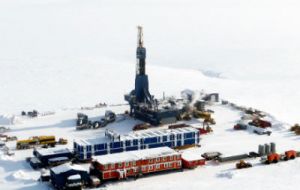MercoPress. South Atlantic News Agency
Repsol announces largest onshore oil discovery in the US in three decades
 Repsol has been actively exploring in Alaska since 2008 and finally hit a big one. The find came after drilling two wells with its partner, Armstrong Oil & Gas.
Repsol has been actively exploring in Alaska since 2008 and finally hit a big one. The find came after drilling two wells with its partner, Armstrong Oil & Gas. Spanish oil firm Repsol SA has announced the largest onshore oil discovery in the U.S. in three decades, a 1.2 billion barrel find on Alaska’s North Slope. Repsol has been actively exploring in Alaska since 2008 and finally hit a big one. The find came after drilling two wells with its partner, Armstrong Oil & Gas.
Repsol says that it if it moves forward and develops the project, first oil could come by 2021. The field could produce 120,000 bpd, a significant volume given the predicament the state of Alaska finds itself in.
Alaskan oil production has been declining for decades. After BP’s massive Prudhoe Bay oil field came online in the 1970s – the largest oil field in North America – Alaska’s oil production shot up. But the field saw its production peak in the late 1980s at 1.5 million barrels per day, after which it went into long-term decline.
The Trans-Alaskan Pipeline System (TAPS) has made oil production on Alaska’s northern coast possible. With a price tag of US$8 billion, the pipeline was the largest privately-funded construction project in the 1970s. The 800-mile pipeline carries oil from Alaska’s northern coast to a terminus on its southern coast in Valdez for export. The pipeline traverses mountain ranges, and much of it has to run at an elevated position above ground because of melting permafrost.
The pipeline is absolutely critical to Alaska’s oil industry – without it, producing on the North Slope never would have gotten off the ground. But falling output levels on the North Slope from aging fields like Prudhoe Bay put the pipeline’s existence into jeopardy.
The pipeline has a throughput capacity of 2 million barrels per day, but actual oil flows have declined to roughly 0.5 mb/d, and are falling by about 5 percent per year. That isn’t just a problem from a revenue standpoint, but also from an operational one. Declining throughput means slower moving oil, which means lower temperatures for that oil.
Slower and colder oil leads to water separating from the oil and freezing. That can damage the pipeline. Also, oil contains some small amounts of wax, and when the crude flow slows and gets cold, wax separates and sticks to the pipeline. Removing that wax requires more cleaning and maintenance, raising costs and operational problems.




Top Comments
Disclaimer & comment rulesCommenting for this story is now closed.
If you have a Facebook account, become a fan and comment on our Facebook Page!